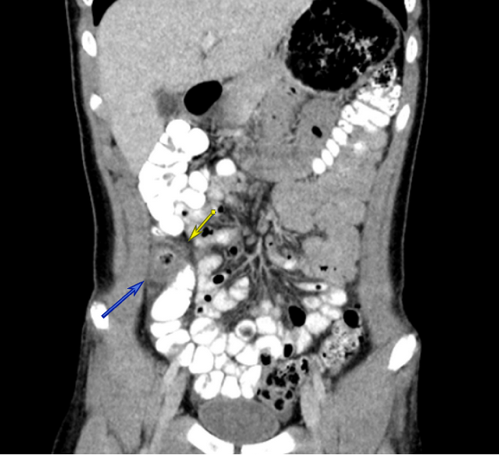Back
Gastroenterology/Hepatology
Category: Abstract Submission
Gastroenterology/Hepatology I
12 - Right-Sided Pediatric Cecal Diverticulitis: Case Report and Literature Review
Saturday, April 23, 2022
3:30 PM – 6:00 PM US MT
Poster Number: 12
Publication Number: 12.207
Publication Number: 12.207
Christian M. Bruni, The Children's Regional Hospital at Cooper, Camden, NJ, United States; Natasha Goulet, Cooper Medical School of Rowan University, Camden, NJ, United States; William Graessle, The Children's Regional Hospital at Cooper, Camden, NJ, United States

Christian M. Bruni, MD, MS
Resident Physician, PGY-3
The Children's Regional Hospital at Cooper
Camden, New Jersey, United States
Presenting Author(s)
Background: Pediatric cecal diverticulitis is an exceedingly rare diagnosis, with only 9 identified cases in the literature at present. The pathophysiology of the disease is thought to be congenital in nature, however, some have speculated underlying genetic etiologies. The incidence and risk factors for this condition are currently unknown.
Objective: This case report aims to discuss a rare presentation of pediatric cecal diverticulitis and demonstrate a novel treatment strategy.
Design/Methods: Single subject case report and literature review.
Results: Here we report the case of a previously healthy 13-year-old male presenting with 1 day of acute nausea and severe non-radiating pain of the right lower quadrant. Pt reported a 1-day history of constipation and was afebrile on admission. He denied a family history of diverticula. Patient did not take any medications on a regular basis and no medical history of any conditions, including those which interfere with gut motility. Physical exam revealed point tenderness of the right lower quadrant with a positive Rovsing sign. Abdomen was soft and nondistended with normoactive bowel sounds throughout. Presumed to be appendicitis, CT imaging of the abdomen revealed an inflamed diverticulum and normal appendix, consistent with the presentation of acute diverticulitis.Conclusion(s): A search of the literature was performed for pediatric cecal diverticulitis, of which 88 articles were identified. Articles were reviewed and excluded based on strict exclusion criteria. A majority of the cases reported (88%) continued onto surgical management. Only 1 identified case used medical management alone employing IV cefotaxime and metronidazole. From our review, our case is the first case treated with medical management initially using ceftriaxone and transitioning to trimethoprim- sulfamethoxazole, which is standard of care in the outpatient management of acute diverticulitis in the adult population and provides broad-spectrum coverage against gram-positive and gram-negative bacteria. Our patient’s pain improved after 1 day of IV ceftriaxone and he was tolerating PO nutrition and antibiotics prior to discharge. This case report will add to the growing body of medical literature of patients with this interesting pathology and further represents a novel treatment strategy in the pediatric population.
Figure 1 Noted focal area of wall thickening in cecum surrounding the inflamed diverticulum. Surrounding soft tissue swelling.
Noted focal area of wall thickening in cecum surrounding the inflamed diverticulum. Surrounding soft tissue swelling.
Objective: This case report aims to discuss a rare presentation of pediatric cecal diverticulitis and demonstrate a novel treatment strategy.
Design/Methods: Single subject case report and literature review.
Results: Here we report the case of a previously healthy 13-year-old male presenting with 1 day of acute nausea and severe non-radiating pain of the right lower quadrant. Pt reported a 1-day history of constipation and was afebrile on admission. He denied a family history of diverticula. Patient did not take any medications on a regular basis and no medical history of any conditions, including those which interfere with gut motility. Physical exam revealed point tenderness of the right lower quadrant with a positive Rovsing sign. Abdomen was soft and nondistended with normoactive bowel sounds throughout. Presumed to be appendicitis, CT imaging of the abdomen revealed an inflamed diverticulum and normal appendix, consistent with the presentation of acute diverticulitis.Conclusion(s): A search of the literature was performed for pediatric cecal diverticulitis, of which 88 articles were identified. Articles were reviewed and excluded based on strict exclusion criteria. A majority of the cases reported (88%) continued onto surgical management. Only 1 identified case used medical management alone employing IV cefotaxime and metronidazole. From our review, our case is the first case treated with medical management initially using ceftriaxone and transitioning to trimethoprim- sulfamethoxazole, which is standard of care in the outpatient management of acute diverticulitis in the adult population and provides broad-spectrum coverage against gram-positive and gram-negative bacteria. Our patient’s pain improved after 1 day of IV ceftriaxone and he was tolerating PO nutrition and antibiotics prior to discharge. This case report will add to the growing body of medical literature of patients with this interesting pathology and further represents a novel treatment strategy in the pediatric population.
Figure 1
 Noted focal area of wall thickening in cecum surrounding the inflamed diverticulum. Surrounding soft tissue swelling.
Noted focal area of wall thickening in cecum surrounding the inflamed diverticulum. Surrounding soft tissue swelling.